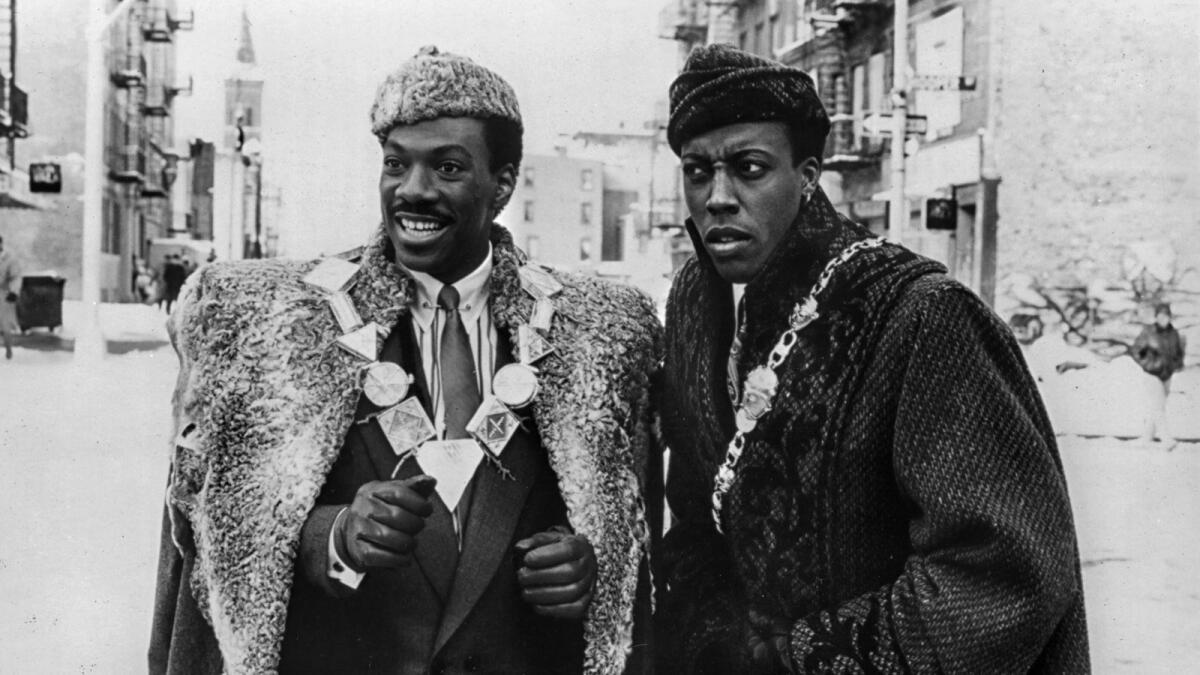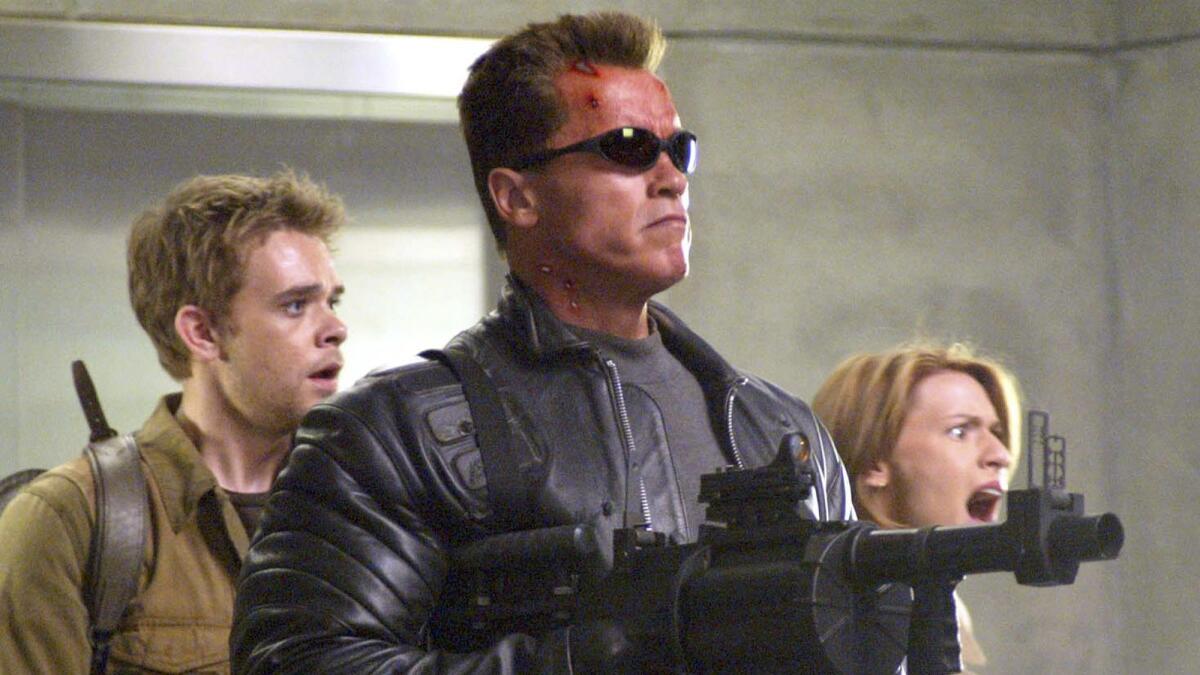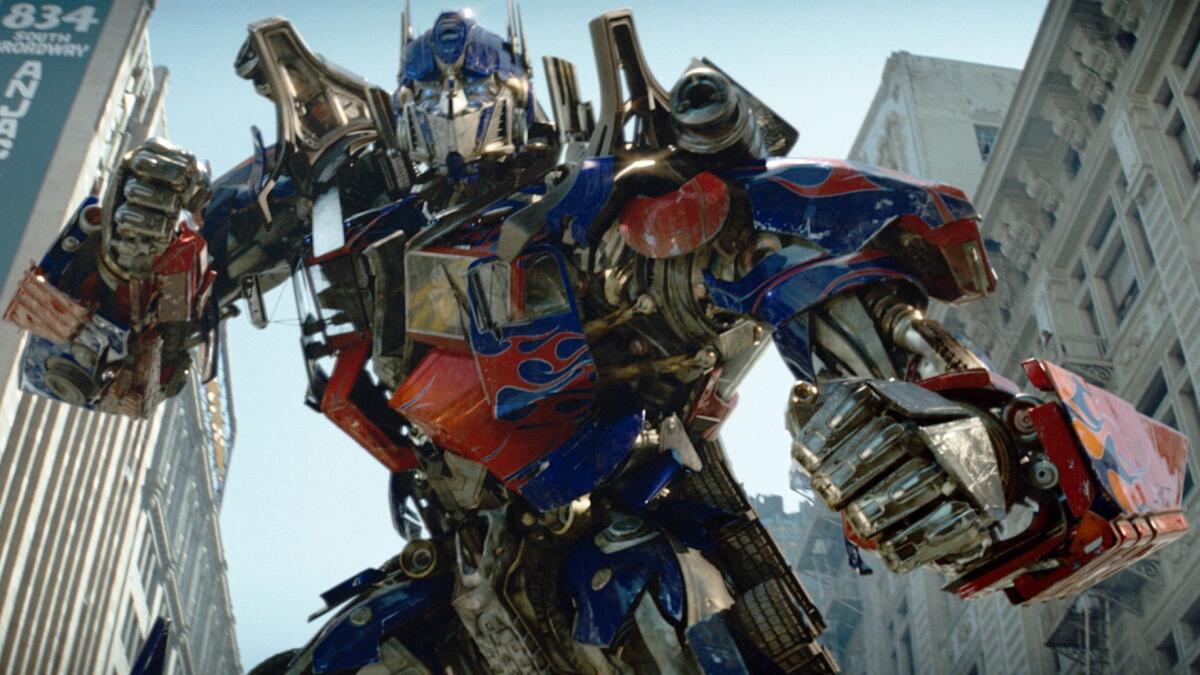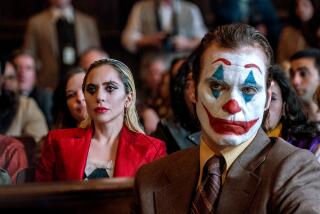From ‘Back to the Future’ to ‘Wild Wild West’: A look at the Fourth of July’s biggest box office hits and misses
The Fourth of July has long been a boon to the box office, with studios pitching their tentpole films on the holiday in hope of taking advantage of the American public’s extra time off (and, in many cases, their need for air conditioning). More than 30 years since Universal successfully launched “Back to the Future” on July 3, the national holiday is now as closely associated with superheroes and Will Smith as much as barbecues and fireworks.
This year, audiences will have their pick at the multiplex, with “Sicario: Day of the Soldado” and “Uncle Drew” both opening June 29, followed by “The First Purge” on July 4, and “Ant-Man and the Wasp” on July 6. Meanwhile “Jurassic World: Fallen Kingdom” will likely still be drawing crowds after its staggering $150-million opening last week.
As the war for this year’s Fourth of July box office winner begins, take a look back at the big box office winners and disappointments.
Note: All box office numbers, and those adjusted for inflation, provided by Box Office Mojo.
1985: “Back to the Future”
Domestic opening: $11.1 million ($28.7 million when adjusted for inflation)
Competition: “Red Sonja,” “The Emerald Forest”
In May 1977, “Star Wars” turned the summertime into a box office gold mine, but studios were still tentative about releasing big movies over the Independence Day weekend, home to many family gatherings, friendly barbecues and fireworks displays. However, Universal had high hopes for their kinetic time travel comedy from director Robert Zemeckis and their ambitions paid off big time with an $11.1-million opening on a $19-million budget. Read the original L.A. Times review
1986: “Psycho III”
Domestic opening: $3.2 million ($7.9 million when adjusted for inflation)
Competition: “Big Trouble in Little China,” “Under the Cherry Moon,” “About Last Night…,” “The Great Mouse Detective”
In a slow year, Prince, John Carpenter and even Disney all took a backseat to the second sequel to the 25-year-old Hitchcock horror classic, although it wasn’t much of a victory as all five wide releases debuted within a few hundred thousand dollars of each other.
1987: “Innerspace”
Domestic opening: $4.7 million ($11.1 million when adjusted for inflation)
Competition: “Adventures in Babysitting”
Joe Dante’s silly sci-fi adventure, starring Dennis Quaid and Meg Ryan, handily topped Chris Columbus’ family comedy. There were plenty of laughs to go around, as the previous week saw the debut of “Dragnet” and “Spaceballs.”

1988: “Coming to America”
Domestic opening: $21.4 million ($47.7 million when adjusted for inflation)
Competition: none
Eddie Murphy was box office gold at this point, following hits like “Trading Places” and “Beverly Hills Cop.” The R-rated “Coming to America,” which opened on June 29, had the holiday to itself, although Zemeckis’ “Who Framed Roger Rabbit?” had opened big just a week earlier and was still luring families. It wasn’t until July 8 when fresh competition arrived in the form of “Arthur 2: On the Rocks,” “License to Drive” and “Short Circuit 2.”
1989: “Karate Kid 3”
Domestic opening: $10.3 million ($23.9 million when adjusted for inflation)
Competition: “Great Balls of Fire!”
The summer already had a box office champ in Tim Burton’s “Batman,” released June 23, and also saw box office winners in sequels like “Ghostbusters 2” and “Lethal Weapon 2.” But, for the July 4 weekend, Ralph Macchio and Noriyuki “Pat” Morita were the team to beat.
1990: “Die Hard 2”
Domestic opening: $21.7 million ($47 million when adjusted for inflation)
Competition: “Jetsons: The Movie”
Independence Day fell on a Wednesday in 1990, but studios failed to take advantage of the potentially elongated weekend. Instead, audiences could choose from two films that opened on Friday, June 29. Tom Cruise’s “Days of Thunder” opened to $15.4 million, while Bill Cosby’s “Ghost Dad” scared up $4.8 million. The following Friday brought “Die Hard’s” Bruce Willis back to the big screen as Det. John McClane and audiences clearly didn’t mind the return trip. Read the L.A. Times review
1991: “Terminator 2: Judgment Day”
Domestic opening: $31.7 million ($69.1 million when adjusted for inflation)
Competition: “Problem Child 2”
Writer-director James Cameron and stars Arnold Schwarzenegger and Linda Hamilton revisited their low-budget 1984 sleeper hit, this time with a lot more money and groundbreaking CGI. The weekend’s other sequel was no match. Read the L.A. Times review
1992: “A League of Their Own”
Domestic opening: $13.7 million ($30.3 million when adjusted for inflation)
Competition: “Boomerang”
In a photo finish, the Tom Hanks-Geena Davis baseball comedy outscored Murphy’s “Boomerang,” which landed in second place with a $13.6 million haul. Both films finished their domestic runs in a virtual tie as well. Read the L.A. Times review
1993: “The Firm”
Domestic opening: $25.4 million ($56.1 million when adjusted for inflation)
Competition: “Son-in-Law,” “Snow White and the Seven Dwarfs” (re-issue)
Cruise’s nearly unprecedented box office streak continued with this John Grisham legal thriller (it was his second of five movies in a row to gross more than $100 million). Other studios began to learn to steer clear of Cruise vehicles. Read the L.A. Times review
1994: “Forrest Gump”
Domestic opening: $24.4 million ($53.6 million when adjusted for inflation)
Competition: “The Shadow,” “Blown Away,” “I Love Trouble” and “Baby’s Day Out”
This was another strange calendar year, when July 4 fell on a Monday. Friday, July 1’s openers included “The Shadow” ($11.7 million), “Blown Away” ($10.4 million), “I Love Trouble” ($7.8 million) and “Baby’s Day Out” ($4 million). Zemeckis’ “Gump,” starring Hanks, then opened on Wednesday, July 6, to a big $24.4 million on its way to a stellar $329.6 million domestic and Oscars for picture, director, lead actor and more.
1995: “Apollo 13”
Domestic opening: $25.3 million ($53.3 million when adjusted for inflation)
Competition: “Judge Dredd,” “Mighty Morphin’ Power Rangers”
Hanks came out on top yet again, re-teaming with director Ron Howard (“Splash”) for this historical drama which appealed to the patriotism of the holiday and provided some high-tech thrills as well. Read the L.A. Times review
1996: “Independence Day”
Domestic opening: $50.2 million ($104 million when adjusted for inflation)
Competition: “Phenomenon”
With a sprawling cast of familiar faces, nifty special effects and, perhaps most importantly, a smart marketing campaign, “ID4” blew up historic landmarks and box office records in equal measure and officially cemented TV star Will Smith as a blockbuster movie breakout. Read the L.A. Times review
1997: “Men in Black”
Domestic opening: $51 million ($101.9 million when adjusted for inflation)
Competition: “Out to Sea”
Smith solidified his status as Mr. Fourth of July when this sci-fi/comedy blasted off at the box office.
1998: “Armageddon”
Domestic opening: $36 million ($70.4 million when adjusted for inflation)
Never mind that “Deep Impact” mined similar story elements just two months earlier. When “Bad Boys” director Michael Bay decided to team with Bruce Willis, Ben Affleck and Aerosmith, other studios balked at the idea of challenging it for the weekend crown.
1999: “Wild Wild West”
Domestic opening: $27.6 million ($49.9 million when adjusted for inflation)
Competition: “South Park,” “An Ideal Husband” and “Summer of Sam”
Smith’s July 4 streak came to an abrupt end with this pricey flop based on the 1960s TV show.
2000: “The Patriot”
Domestic opening: $22.4 million ($38 million when adjusted for inflation)
Competition: “Perfect Storm,” “The Adventures of Rocky and Bullwinkle”
“Independence Day” director Roland Emmerich appealed to the patriotic sector of the movie-going public even more directly with this tale of the American Revolution starring Mel Gibson and fellow Australian Heath Ledger. Read the L.A. Times review
2001: “Cats & Dogs”
Domestic opening: $21.7 million ($35.1 million when adjusted for inflation)
Competition: “Scary Movie 2,” “Kiss of the Dragon”
Another July 4 with no runaway hit, 2001 found “Scary Movie 2” in second place with $20.5 million, but the family-friendly “Cats & Dogs” won by a whisker. Read the L.A. Times review
2002: “Men in Black II”
Domestic opening: $52.1 million ($82.2 million when adjusted for inflation)
Competition: “Like Mike,” “Powerpuff Girls”
Smith retook the July 4 crown with this pricey sequel. Although it enjoyed a bigger opening that the original, the follow-up’s domestic haul fell short of the previous film’s $250 million total.

2003: “T3: Rise of the Machines”
Domestic opening: $44 million ($66.9 million when adjusted for inflation)
Competition: “Legally Blonde 2,” “Sinbad: Legend of the Seven Seas”
Cameron sat this one out, but Schwarzenegger still made the return trip as the futuristic cyborg. The third chapter failed to reach the same box office heights as its precursor, but was enough to win the weekend and keep the franchise afloat.
2004: “Spider-Man 2”
Domestic opening: $88.1 million ($130 million when adjusted for inflation)
Spidey’s second big screen outing swung to a mighty $88 million over the holiday. A victory to be sure, but two years earlier, the original “Spider-Man” opened to a massive $144.8 million.
2005: “War of the Worlds”
Domestic opening: $64.8 million ($92.7 million when adjusted for inflation)
Competition: “Rebound”
2005’s Independence Day went dark, with Steven Spielberg’s bleak update of H.G Wells’ already bleak classic starring Cruise. Audiences still came out in droves, despite the film’s downbeat nature, which was atypical for July 4 fare.
2006: “Superman Returns”
Domestic opening: $52.5 million ($73.4 million when adjusted for inflation)
Competition: “The Devil Wears Prada”
Some 20 years after Christopher Reeve hung up the cape, and a decade before Henry Cavill suited up, Brandon Routh played the world’s most famous superhero for this one-off from director Bryan Singer.

2007: “Transformers”
Domestic opening: $70.5 million ($93.8 million when adjusted for inflation)
Competition: “License to Wed,” “Sicko”
Bay’s massive toy-inspired franchise began with a big box office bang and has become as ubiquitous in the summertime as lemonade stands and sunburns. Read the L.A. Times review
2008: “Hancock”
Domestic opening: $62.6 million ($79.8 million when adjusted for inflation)
Competition: “Kit Kitteridge: An American Girl”
Smith wins again, this time playing against type as a drunken, selfish superhero. Read the L.A. Times review
2009: “Ice Age: Dawn of the Dinosaurs”
Domestic opening: $41.6 million ($51.1 million when adjusted for inflation)
Competition: “Public Enemies”
The success of “Dawn of the Dinosaurs” illustrates two things that audiences have embraced over the July 4 holiday in recent years: Animation and sequels. Read the L.A. Times review
2010: “Twilight Saga: Eclipse”
Domestic opening: $64.8 million ($77 million when adjusted for inflation)
Competition: ”The Last Airbender”
It wasn’t so long ago that one of the few surefire hits not involving superheroes or giant robots was a YA franchise with a sparkling vampire at its center. The third film in the series, “Eclipse” endured the lowest opening of the series, but went on to score the biggest domestic total. Read the L.A. Times review
2011: “Transformers: Dark of the Moon”
Domestic opening: $97.8 million ($112.8 million when adjusted for inflation)
Competition: “Larry Crowne,” “Monte Carlo”
The third “Transformers” entry offered more robots, more explosions, more more, although it didn’t reach the same box office highs as its 2009 predecessor. Read the L.A. Times review
2012: “Amazing Spider-Man”
Domestic opening: $62 million ($73 million when adjusted for inflation)
Competition: “Katy Perry: Part of Me,” “Savages”
After three hit films with Tobey Maguire as the webslinger, Sony rebooted the series with Andrew Garfield in the lead role. The box office numbers held strong. What superhero fatigue? Read the L.A. Times review
2013: “Despicable Me 2”
Domestic opening: $83.5 million ($97.5 million when adjusted for inflation)
Competition: “The Lone Ranger”
Universal’s animated sequel to the surprise 2010 smash outshone the original at the box office. However, the weekend’s real story was that Disney suffered a massive misfire with “The Lone Ranger,” starring Armie Hammer as the title hero and Johnny Depp as Tonto. Budgeted north of $200 million, the film opened to $29.2 million and limped to a North American total of $89.3 million. Read the L.A. Times review
2014: “Tammy”
Domestic opening: $21.5 million ($24.4 million when adjusted for inflation)
Competition: ”Deliver Us From Evil”
After a string of inexpensive hits like “Bridesmaids,” “Identity Thief” and “The Heat,” Melissa McCarthy continued her box office streak with the comedy “Tammy.” Read the L.A. Times review
2015: “Terminator: Genisys”
Domestic opening: $27 million ($29.9 million when adjusted for inflation)
Competition: “Magic Mike XXL”
This was the fifth “Terminator” film, and was heralded as the return of Schwarzenegger after he took a break during 2009’s “Terminator: Salvation.” The film’s opening take still disappointed. Read the L.A. Times review
2016: “The Legend of Tarzan”
Domestic opening: $38.5 million ($41.4 million when adjusted for inflation)
Competition: “The BFG,” “The Purge: Election Year”
2016’s Independence Day box office frame was a particular disappointment, as Spielberg’s “The BFG” tanked and “Tarzan’s” No. 1 opening earned just under $40 million. Read the L.A. Times review
2017: “Despicable Me 3”
Domestic opening: $72.4 million ($74.2 million when adjusted for inflation)
Competition: “The House”
The Steve Carell-voiced Gru returned, this time with twin brother Dru in tow, to once again top the box office. The 2015 spin-off “Minions” also scored with audiences, with a sequel planned for 2020. Read the L.A. Times review
More to Read
Only good movies
Get the Indie Focus newsletter, Mark Olsen's weekly guide to the world of cinema.
You may occasionally receive promotional content from the Los Angeles Times.











